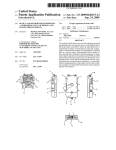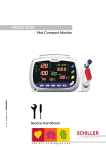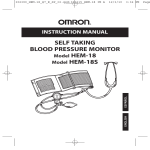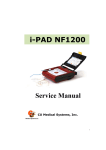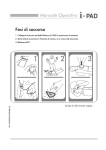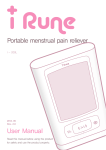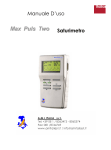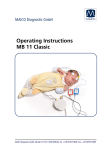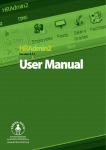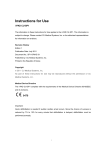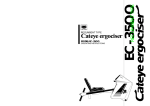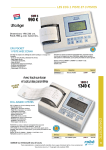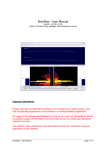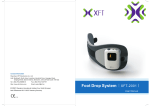Download CUPH2 Patient Monitor
Transcript
C U – P H2 CardioMeter Series i-VIEWER Operator’s Manual CU Medical Systems, Inc. 1 Operator’s Manual i-VIEWER CU-PH2 ver 1.00 2 OPERATOR’S MANUAL Version 1.00 Notice: This Operator’s Manual applies to i-VIEWER CU-PH2, the portable ECG and SPO2 monitoring equipment from CU Medical Systems, Inc. The information contained in this manual is subject to change without prior notice. Copyright Copyright © 2006 CU Medical Systems, Inc. Medical Instrument Industry Park 1720-26 Taejang-Dong, Wonju-Si, Kangwon-Do Korea This document may not be reproduced without prior written consent of CU Medical Systems, Inc. 3 Table of Contents Table of Contents .................................................................................. 4 General................................................................................................. 6 Warranty .............................................................................................. 7 Service Request..................................................................................... 8 Contact Us ............................................................................................ 9 1. How to Use This Manual ................................................................... 10 1.1 Contents of This Manual........................................................... 10 1. 2 Safety Messages.................................................................... 11 2. Device Operation Guidelines............................................................. 2.1 Storage and Operating Environment Guidelines............................. 2.2 Notes On Electrical Safety ........................................................ 2.3 Cleaning and Maintenance ........................................................ 12 12 14 15 3. Introduction.................................................................................... 3.1 Product Description................................................................. 3.1.1 Controls and Ports........................................................ 3.1.2 ACCESSORIES............................................................. 3.1.3 Optional Accessories..................................................... 3.2 Intended Use ......................................................................... 16 16 17 20 22 23 4. Operating Controls, Indicators, Ports, And Accessories....................... 4.1 Operating Controls.................................................................. 4.2 Indicator Lamps ..................................................................... 4.3 Ports.................................................................................... 4.4 Equipment Symbols ................................................................ 23 23 24 24 25 5. OPERATION..................................................................................... 5.1 Unpacking ............................................................................. 5.1.1 Battery Installation....................................................... 5.2 Screen Display....................................................................... 5.3 User Interface........................................................................ 5.3.1 Device Setting Submenu ............................................... 5.3.2 Monitoring Setting........................................................ 5.3.3 Record Review............................................................. 5.3.4 Save And Exit.............................................................. 5.4 Using The i-Viewer CU-PH2....................................................... 5.4.1 ECG Acquisition Using the 3 Electrode ECG Cable Assembly .. Step 1: Preparation..................................................... Device Preparation............................................. User/Patient Preparation..................................... Step 2: Ecg Signal Acquisition ....................................... 5.4.2 ECG Acquisition Using the 5 Electrode ECG Cable Assembly .. 5.4.3 SPO2 Monitoring.......................................................... Pulse Oximetry Sensors ............................................... Application and Connection of the Sensor ........................ SPO2 Monitoring......................................................... SPO2 Monitoring Notes and Warnings ............................. 26 26 26 27 29 29 33 35 38 39 39 39 39 39 41 42 43 44 45 45 46 4 6. Maintenance And Troubleshooting .................................................... 6.1 Maintenance .......................................................................... 6.2 Cleaning The i-Viewer CU-PH2................................................... 6.3 Troubleshooting Guide ............................................................. 6.4 Device Life ............................................................................ 48 48 50 50 51 7. Safety Considerations ...................................................................... 52 8. Data Management And Review.......................................................... 55 9. Specifications.................................................................................. 56 5 General Thank you for choosing the i-Viewer CU-PH2. Please read this Operator’s Manual carefully and thoroughly before using the i-Viewer CU-PH2. This Manual contains instructions on how to operate and maintain the i-Viewer CU-PH2. The features of the i-Viewer CU-PH2 are all discussed in this Manual. It is very important for you to fully understand all the instructions and guidelines discussed in this Manual in order to fully utilize the features of this device and to ensure safe operation. CU Medical Systems, Inc. designs and manufactures all its products in accordance with international standards (NS-EN ISO9001:2000/ ISO13485:1996-MDD 93/42/EEC). This ensures that CU Medical Systems, Inc. provides products of high quality and reliability. In this regard: Only persons authorized by CU Medical Systems, Inc. must do all servicing of the device. ? You must ensure that the correct batteries are properly installed before using this device. ? You must operate this device in accordance with the instructions specified in this manual. ? To ensure safety and reliability, use only parts and accessories recommended by CU Medical Systems, Inc. 6 Warranty ? The products of CU Medical Systems, Inc. are designed and manufactured according to international standards (NS-EN ISO9001:2000/ ISO13485:1996-MDD 93/42/EEC). Every device that goes out of the assembly line passes through a battery of reliability tests. In case of problems, our maintenance and exchange policies are in accordance with the relevant consumer protection laws and regulations of the particular country where this device is sold. ? The warranty period of this device is within two years after the date of purchase. ? When the device malfunctions during the warranty period, it will be repaired free of charge at our service centers. ? When you submit the device for maintenance, please specify the details as listed below : The device model, serial number, date of purchase, name of sales representative, customer information and a brief description of the problems. Name of Product Model CardioMeter i-Viewer CU-PH2 Date of Purchase Serial No. Sales Representative Name Customer Information Address Contact No. Brief Description of Problems 7 Service Request Only CU Medical Systems, Inc. or its authorized representatives should service the device. If the device is serviced by unauthorized personnel during the warranty period, the warranty will become null and void. CU Medical Systems, Inc. or its authorized representatives are obliged to service the device free of charge during the warranty period. Damage to the device incurred beyond normal use is not covered by the warranty. When the device is not functioning properly, it has to be submitted for maintenance immediately. When any problems are found in the device or when a danger to bodily harm exists, the device has to be repaired immediately by authorized personnel. When the need for maintenance arises: ? Please contact CU Medical Systems, Inc. or its authorized representatives immediately. Prepare a summary of the problems. 8 ? Contact Us You can contact us at the following address and telephone number for services and supplies. Product and Order Inquiries: International Marketing Team CU Medical Systems, Inc. Medical Instrument Industry Park 1720-26 Taejang-Dong, Wonju-Si, Kangwon-Do Korea Tel : +82 33 747 7657 Fax : +82 33 747 7659 email address: [email protected] Service Request and Technical Support Customer Service Team CU Medical Systems, Inc. Medical Instrument Industry Park 1720-26 Taejang-Dong, Wonju-Si, Kangwon-Do Korea Tel : +82 33 747 7657 Fax : +82 33 747 7659 email address: [email protected] Our website: http://www.cu911.com Authorized European Representative of CU Medical Systems, Inc. A.M.I Italia s.r.l Via Cupa Reginella N 17A 80010 Quarto (Napoli) Italy Tel No 0039 (0) 81 806 34 75 0039 (0) 81 806 34 75 Fax No 0039 (0) 81 876 47 69 Email: [email protected] Website: www.amitaliasrl.it 9 1 How to Use This Manual 1.1 Contents of This Manual ? This Operator’s Manual contains all the information a user needs to operate the i-Viewer CU-PH2 properly. The i-Viewer CU-PH2 is designed to acquire, display, and extract the heart rate of the ECG of a patient/user. The i-Viewer CU-PH2 is also equipped with the capability to monitor the SPO2 of a patient. ? In case you have any problems regarding the operation of the device, please don’t hesitate to contact us. ? Specifications and information in this manual are subject to change without prior notice. 10 1. 2 Safety Messages Safety messages are used throughout this manual to emphasize important things that must be followed during the operation of the i-Viewer CU-PH2. You must follow the instructions in all the Warnings, Cautions, and Notice messages found throughout this Operator’s Manual In the event that the product is damaged due to misuse or negligence by a user, the manufacturer or its authorized representatives shall not be responsible for the said damage or loss to the product. Conditions, hazards, or unsafe practices that can result in serious personal injury. Conditions, hazards, or unsafe practices that can result in minor personal injury, damage to the CU-PH2, or loss of data stored in the device. These messages are used to denote items that are important during installation, operation, or maintenance of the device. 11 2 Device Operation Guidelines 2.1 Storage and Operating Environment Guidelines Do not operate or store the device in conditions that are beyond the following specified limits. Operating Conditions Temperature 0 °C to 50 °C Humidity 5 % to 95 % (non-condensing) Storage Conditions Temperature -20 °C to 70 °C Humidity 5 % to 95 % (non-condensing) Do not store the device in areas that are directly exposed to sunlight Do not store the device in areas with highly fluctuating temperatures Do not store the device near heating equipment Do not store the device in areas where there is high vibration (in excess of Category 10 of MIL-STD810E) Do not operate or store the device in areas with high concentration of dust Only personnel authorized by the manufacturer shall open the device for servicing. 12 The following are the general guidelines in storage and operating environment conditions. ? Do not expose the device to direct sunlight during storage. ? Do not store the device in locations with temperature and humidity conditions that are beyond the specified safe range Temperature: -20°C to 70°C Relative Humidity: 5% to 95% (non-condensing) ? Do not store the device close to heating equipment and appliances. ? Do not store the device near sources of vibration. ? Do not store and operate the device in locations that are exposed to chemicals, explosive gas and solvents. ? Keep the device away from dusty environments. ? There are no user serviceable parts inside the i-Viewer CU-PH2. Only authorized service personnel should open the device for repairs. The Standard Operating Conditions are as Follows: ? ? Temperature: 0 °C to 50 °C Relative Humidity: 5 % to 95 % (non-condensing) The standard storage and shipping conditions are as follows: ? ? Temperature: -20 °C to 70 °C Relative Humidity : 5 % to 95 % (non-condensing) 13 2.2 Notes On Electrical Safety During operation, the device should be placed away from sources of electromagnetic interference such as motors, generators, X-Ray equipment, radio transmitters, cellular mobile telephones and others, as these might interfere with the signals being acquired. The i-Viewer CU-PH2 is classified as follows: - It is a Class I, Type CF equipment in terms of electrical shock prevention (EN 60601-1). It is not proper to operate this device around combustible anesthetic or solvents. - The noise level is “B” Class according to EN 60601-1 (Safety of Electric Medical Equipment), and the noise redemption is “B” level according to the EN 60601-1-2 (Electromagnetic Compatibility Requirements). 14 2.3 Cleaning and Maintenance When the case is contaminated with dirt, clean the i-Viewer CU-PH2 using a soft, damp cloth moistened with any of the following solvents: Soap and water 70% solution isopropyl alcohol Chlorine bleach and water mixture (30 ml bleach/liter of water) Ammonia-based cleaners Hydrogen peroxide Do not immerse any part of the i-Viewer CU-PH2 in fluids. Do not let any fluid enter the case of the device. Do not spill liquids on the case of the device. Do not use strong, acetone-based cleaners in cleaning the device. Do not use abrasive materials in cleaning the unit, especially the LCD display and the infrared filter on the IrDA port. Do not sterilize the i-Viewer CU-PH2. Although there are no user serviceable parts inside the i-Viewer CU-PH2, you can do some maintenance check that will help ensure that the device stays in mint condition. ? ? ? Check the case of the device for any apparent damage. Check the ports (ECG connector port) to see that it is tightly in place. Check the accessories, especially the ECG electrodes, to see that they are in good condition and that they have not yet reached their expiration dates. A more comprehensive maintenance routine is discussed in the chapter on Maintenance of this User’s Manual. 15 3. INTRODUCTION 3.1 PRODUCT DESCRIPTION The i-Viewer CU-PH2 is a lightweight, portable, battery operated, 5-lead Electrocardiogram (ECG) and SPO2 monitoring device. It has a high resolution (320x240 pixels) liquid crystal display (LCD). One of the leads and the plethysmographic wave is displayed simultaneously. The i-Viewer CU-PH2 runs on four AAA size 1.5V batteries. It may also run using a supplied AC/DC adapter. ECG signal acquisition is achieved through a five-electrode ECG acquisition assembly with disposable electrodes while SPO2 signal acquisition is done using the recommended Nellcor SPO2 Sensors. User interaction is through three function buttons (LEFT, RIGHT, and MENU). Through these buttons, the settings of the device can be changed. ECG signals can be recorded in the internal nonvolatile memory of the device. The stored signals can later be reviewed. These recorded signals can also be transferred to a personal computer that is running the CU Expert ECG Data Management Software. The CU Expert is available as an option. The i-Viewer CU-PH2 analyzes the signal it acquires from the user and determines the heart rate of the user. The device prompts the user through the beeper and the LED alarm indicator if it detects an abnormal heart rate. Abnormal heart rate is any heart rate beyond the normal limits defined by the user. 16 3.1.1 Controls and Ports i-Viewer CU-PH2 top view Power indicator Green LED, lit when the device is ON. Power switch Used to turn the device ON or OFF Alarm LED Red LED, flashes when the device detects an ECG signal with beat rate that is beyond the normal range defined by the user. LCD display Displays the following: a. ECG signal acquired from the patient b. ECG signal recorded in the memory of the device c. Plethysmographic wave of the patient. d. Menu e. Device settings LEFT arrow button Used to scroll the menu highlight to the left or upward. This button is also used to change the Lead of the ECG signal being acquired. MENU button Used to activate the menu. When the menu is activated, it is used to select the highlighted menu item RIGHT arrow button Used to scroll the menu highlight to the right or downward. This button is also used to turn the QRS beeper ON or OFF 17 i-Viewer CU-PH2 right side view IrDA port used to transmit data from the i-Viewer CU-PH2 to a personal computer using an IrDA transmission. UART port used to transmit data from the i-Viewer CU-PH2 to a personal computer using serial wired connection. i-Viewer CU-PH2 back side view SpO2 Sensor Port used to connect the SpO2 sensor to the i-VIEWER CU-PH2 ECG Sensor Port used to connect the ECG electrode assembly to the iVIEWER CU-PH2 AC/DC Power Port used to connect the AC/DC adapter to the i-VIEWER CUPH2 18 i-Viewer CU-PH2 Bottom View Battery Cover covers the battery compartment. The battery compartment contains the four AA batteries that are used to power the device. 19 3.1.2 ACCESSORIES 5-electrode Cable and Connector Assembly 3-electrode Cable and Connector Assembly ECG Sensor Port Connector used to connect the cable and connector assembly to the i-Viewer CU-PH2 Snap Electrode Connector used to connect the cable and connector assembly to the disposable ECG electrodes. 20 Disposable ECG Electrodes Snap Connector used to connect the electrode to the cable assembly SPO2 Sensor Assembly SPO2 Sensor used to acquire the SPO2 signal from the patient SPO2 Sensor Port Connector used to connect the sensor assembly to the SPO2 sensor port on the i-Viewer CU-PH2 21 3.1.3 Optional Accessories ? Leather Case ? Cradle ? CU Expert Patient Management Software ? IrDA Cable ? UART Cable 22 3.2 INTENDED USE The i-Viewer CU-PH2 is intended for ECG and SPO2 signal monitoring. It is intended for the continuous non-invasive monitoring of ECG, functional oxygen saturation of arterial hemoglobin (SPO2) and pulse rate. It is intended for use with neonatal, pediatric, and adult patients during both no motion and motion conditions and for patients who are well or poorly perfused, in hospitals, hospital-type facilities, intra-hospital transport, and home environments. For prescription use only. Hospital use typically covers such areas as general care floors, operation rooms, special procedure areas, intensive and critical care areas, within the hospital plus hospital-type facilities. Hospital-type facilities include physician office based facilities, sleep labs, skilled nursing facilities, surgicenters, and sub-acute centers. Intra-hospital transport includes transport of a patient witching the hospital or hospital-type facility. Home Care use is defined as managed/used by a lay person (parent or other similar non-critical caregiver) in the home environment. 4. OPERATING CONTROLS, INDICATORS, PORTS, AND ACCESSORIES 4.1 OPERATING CONTROLS Turns the power of the i-Viewer CU-PH2 ON or OFF. ON/OFF Switch LEFT BUTTON RIGHT BUTTON a. Scrolls the Menu highlight UP or to the LEFT b. Scrolls the ECG record to the left (displaying the earlier parts of a recorded ECG) during RECORD REVIEW c. Changes the ECG Lead acquired by the device when pressed during ECG acquisition. a. Scrolls the Menu highlight DOWN or to the RIGHT b. scrolls the ECG record to the right (displaying the later parts of a recorded ECG) during RECORD REVIEW c. Turns the QRS beep ON or OFF Used to activate the menu select an item during menu operation. MENU BUTTON 23 4.2 INDICATOR LAMPS POWER ON LED ALARM LED When ON, indicates that the i-Viewer CU-PH2 is ON. This LED is colored green When ON, indicates an abnormal ECG or SPO2. This is used together with the beeper. This LED is colored RED 4.3 PORTS ECG Sensor Port used to connect the ECG electrode assembly to the i-Viewer CU-PH2 SPO2 Sensor Port used to connect the SpO2 sensor to the i-Viewer CU-PH2 IrDA PORT used to transmit data from the i-Viewer CU-PH2 to a personal computer using an IrDA transmission. UART PORT used to transmit data from the i-Viewer CU-PH2 to a personal computer using serial wired connection. AC/DC Power port used to connect the AC/DC adapter to the iViewer CU-PH2 24 4.4 Equipment Symbols Power ON/OFF Switch Attention, consult accompanying documents Date of manufacture Signal transfer port IrDA Infrared data communications port Battery state :displayed on LCD screen Symbol of data recording: displayed on LCD screen. QRS beeper state indicator: displayed on LCD screen. 25 5. OPERATION 5.1 UNPACKING Upon receiving the device: 1) Carefully inspect the packing container for any apparent damage. 2) Inspect the unit for apparent damage that it might have sustained during shipping. 3) Check the shipping list to ensure that the unit comes with the complete accessories. 5.1.1 Battery Installation The battery compartment cover of the i-Viewer CU-PH2 is located at its bottom side. Slide the cover as indicated (see the bottom view figure in section 3.1) The i-Viewer CU-PH2 needs four (4) 1.5V AA size batteries. The polarities are shown inside the battery compartment. Avoid storing the batteries at extreme temperatures. Batteries perform best when stored and used between –15 °C and 55 °C Keep batteries in low humidity locations with low temperature variations. Keep batteries away from direct sunlight. Do not attempt to recharge non rechargeable batteries. 26 5.2 SCREEN DISPLAY Upon turning the device ON, it will display the screen shown below 5 LEAD ? 10 --? II ? BPM -- % ? ? LEADS OFF PROBE OFF ? 00:05:23 Screen Display of the i-Viewer CU-PH2 LEAD 1 ? States BPM source and QRS detection States BPM display States QRS beep 4 ? Indicates the source of the BPM value calculation and the detection of QRS waves in the acquired ECG signal Displayed – the source of the BPM calculation is the ECG signal Not displayed – the source of the BPM calculation is the SPO2 signal. 2 ? 3 ? Indicates the lead number of the ECG signal being displayed I – indicates that LEAD I bipolar limb lead is being displayed II - indicates that LEAD II bipolar limb lead is being displayed III - indicates that LEAD III bipolar limb lead is being displayed aVR – indicates that LEAD aVR is being displayed. aVL - indicates that LEAD aVL is being displayed. aVF - indicates that LEAD aVF is being displayed. V - indicates that LEAD V is being displayed. States heart icon is not flashing– indicates that no QRS wave is detected heart icon is flashing - indicates that QRS wave is detected. Heart icon alternates between small and large sizes to simulate heart beat display Displays the heart rate (in bpm) of the acquired ECG signal or the pulse rate of the acquired SPO2 signal BPM rate is displayed when it falls within the limits of 30 and 300 bpm is displayed when the heart rate is beyond the limits of 30 and 300 bpm Turns the QRS-synchronized beep ON or OFF indicates that the QRS-synchronized beep is ON indicates that the QRS-synchronized beep is OFF ECG Gain 5 ? States Indicates the gain setting of the ECG display in mm/mV 5 the ECG is displayed with a 5 mm/mV gain 10 the ECG is displayed with a 10 mm/mV gain 20 the ECG is displayed with a 20 mm/mV gain A the ECG is displayed with autoscaled gain. When the peak to peak value of the acquired signal is within 0.3 mV to 1 mV, the ECG is displayed using 10mm/mV. When the acquired signal is beyond the range 0.3 mV to 1 mV, the peak to peak value is displayed as 10 mm on the LCD screen. 27 Screen display continued 6 ? Main display States 7 ? Sensor connection status States Battery State Indicator 8 ? States Displays the acquired signal from the user. This may either be the ECG or the plethysmographic wave. Displays ECG signal in the range 0.05mV to 5.5 mV Displays the plethysmographic wave of the patient. Indicates when the leads or the SPO2 probe is OFF. Displays the prompt “LEAD FAULT ” Indicates the charge status of the batteries The battery life is determined using Duracell batteries. indicates that the battery has full charge. In this state, the battery can run the device continuously for approximately 5 hours indicates that the battery has medium charge. In this state, the battery can run the device continuously for approximately 3 hours indicates that the battery has low charge. In this state, the battery can operate for approximately one hour indicates that the battery is almost empty. In this state, the battery can run the device continuously for approximately 15 minutes more. When the battery is empty, the prompt “BATTERY IS EMPTY” is displayed at the center of the LCD screen. indicates that the i-Viewer CU-PH2 is powered using the AC/DC adapter. Time 9 ? States ? 10 Plethysmo graphic wave display States SPO2 Value ? Displays the time elapsed since the device was turned ON. Format is hours:minutes:seconds The elapsed time from 00:00:00 to 99:59:59 is displayed. If the device is ON beyond 99:59:59, the display wraps around to 00:00:00 Displays the plethysmographic wave of the patient Plethysmographic wave display if both ECG and plethysmographic wave are displayed. Alarm limits if only the ECG or the plethysmographic wave is displayed. Displays the SPO2 value of the patient. 11 States Recording indicator 12 ? States 13 ? Memory space indicator States 70% to 100% SPO2 value Indicates the recording status of the i-Viewer CU-PH2 recording is ongoing No recording; memory is full. Indicates the availability of memory space. Not displayed: Memory space is available Displayed and flashing: 9 out of 10 memory partitions are used up and there is memory for at most 2 hours of recording time. 28 5.3 USER INTERFACE The menu is activated by pushing the MENU button. The highlight can be scrolled sideways or up and down by pushing the RIGHT or LEFT button. The submenu field values are scrolled by pressing the MENU button. The heart rate and SPO2 limit values are incremented/decremented using the RIGHT or LEFT buttons. For example, to change the BACKLIGHT settings, highlight the BACKLIGHT option and then cycle through the choices (ON, OFF, 5 SEC) by pressing the MENU button repeatedly. When the desired setting is selected, effect the change by moving the highlight away from the BACKLIGHT option using the RIGHT or LEFT key. There are four main MENU items. These are: a. Device Setting – enables the user to change device configuration b. Monitoring Setting – enables the user to change ECG and SPO2 acquisition parameters. c. Record Review – enables the user to review the recorded ECG signals. The average bpm trend can also be tracked under the Review submenu. d. Save and Exit – used to exit from the MENU and go back to the ECG display screen. When the MENU button is pushed while the device is ON, the following is displayed: The arrow buttons can be used to scroll the highlight across the main menu items: DEVICE SETTING, MONITORING SETTING, RECORD REVIEW, and SAVE AND EXIT. When the RIGHT arrow button is pushed, the highlight scrolls to the right. When the LEFT arrow button is pushed, the highlight scrolls to the left. 5.3.1 DEVICE SETTING SUBMENU When the MENU button is pushed while DEVICE SETTING is highlighted, the menu goes one level down and the highlight can be scrolled up and down from BACKLIGHT to RETURN TO UPPER MENU. Any sub item is entered by pushing the MENU button while the sub item is highlighted. 29 DEVICE SETTING SUBMENU ITEMS Submenu Item BACKLIGHT SYSTEM TIME Settings ON The backlight is always ON. Setting is changed by pressing the MENU button. OFF The backlight is always OFF 5 SEC The backlight is ON for 5 seconds when any key is activated (LEFT ARROW, MENU, RIGHT ARROW). The backlight turns OFF after 5 seconds. Pressing the MENU button while SYSTEM TIME is highlighted displays the following: Pressing the RIGHT or LEFT button cycles the highlight through MONTH – DAY – YEAR – AM/PM – HOUR – MINUTE – RETURN TO UPPER MENU Pressing the MENU button while any of the date variables is highlighted enables the user to change the date or time variable. Values are changed by pressing the LEFT or RIGHT button. After the variable is set, the user must press the MENU button to go one level higher in the menu subsystem. 30 Submenu Item SEND TO PC Settings Pressing the MENU button while SEND TO PC is highlighted displays the following: PC COMMUNICATION NOV . 11 . 2005 15 : 37 : 54 ? ? RECORDING 1/7 MEMORY USE : 70 % Pressing the RIGHT or LEFT button cycles the screen through all the recordings, the LINK SELECT screen and the EXIT screen. Pressing the MENU button while any of the recording summaries is displayed sends the recording to the PC. PC COMMUNICATION LINK SELECT ? ? UART MEMORY USE : 70 % Pressing the MENU button while the LINK SELECT screen cycles the setting between IrDA and UART. PC COMMUNICATION EXIT ? ? MEMORY USE : 70 % Pressing the MENU button while the EXIT screen is displayed takes the MENU to one sublevel higher. ECG LEAD 5 LEAD The PH2 is capable of displaying Leads I, II, III, aVR, aVL, aVF, and V. Setting is changed by pressing the MENU button. 3 LEAD The PH2 is capable of displaying Leads I, II, and III 31 The backlight draws a considerable amount of power. When it is on, the battery will be depleted faster than when the backlight is disabled. It is recommended that the backlight be turned ON only when absolutely necessary e.g. device operation in dark places Data Transmission to a Personal Computer Data is transmitted to a personal computer using the IrDA Com Port Serial Adapter or the UART cable. The CU Expert ECG Data Management Software must also be running on the PC during data transmission (see CU Expert User’s Manual). To transfer data to a personal computer, do the following steps. 1. 2. 3. 4. 5. 6. Connect the IrDA Com Port Serial Adapter or the UART cable to the COM 1 or COM 2 port of the PC. If the IrDA port is used, align the IrDA transceiver of the IrDA Com Port Serial Adapter to the IrDA port of the i-Viewer CU-PH2. If the UART port is used, connect the UART cable to the ECG/UART port of the i-Viewer CU-PH2. Open the CU Expert ECG Data Management Software in the PC. Set the options in accordance with the instructions given in its User’s Manual. Make the connection by performing the following step: ? Open the serial port and click the OK button in the dialog that prompts for the reception to begin. In the i-Viewer CU-PH2, set the appropriate PC link (UART or IrDA). Choose the recording to be transmitted and begin transmission by pressing the MENU button. When transmission begins, the following screen is displayed in the LCD display of the i-Viewer CU-PH2 TEXT PROMPT 7. 8. 9. The text prompts indicate the status of the data transmission. The following are the text prompts that the i-Viewer CU-PH2 displays. a.PREPARING FOR TRANSMISSION – the i-Viewer CU-PH2 is preparing for transmission b.TRANSFERRING DATA – data is being transferred through the IrDA port c. TRANSMISSION COMPLETE – the data transmission is finished d.TRANSMISSION ERROR OCCURRED – the data transfer failed As the data transfer proceeds, the data transfer progress will be shown through the progress bar. When the transmission is finished, the “TRANSMISSION COMPLETE” text prompt is displayed. After the data transmission is finished, turn OFF the i-Viewer CU-PH2. 32 5.3.2 MONITORING SETTING MONITORING SETTING 40 TO 170 BPM 90 TO 99 % ALARM ECG GAIN 10 mm/mV SWEEP SPEED 25 mm/sec DISPLAY ECG SPO2 RETURN TO UPPER MENU Submenu Item ALARM Settings Pressing the MENU button while ALARM is highlighted displays the following screen: ALARM SETTING USER DEFINE UNDER OVER ALARM BPM LIMIT 40 170 OFF SPO2 LIMIT 90 99 OFF RETURN TO UPPER MENU The screen enables the user to set the limits of the ALARM system of the i-Viewer CU-PH2. Pressing the RIGHT or LEFT button cycles the highlight through lower limit, upper limit, and alarm status of ECG and SPO2 alarms. Pressing the MENU button while one of the limits or the alarm status is highlighted enables the user to set the limits or the status. ALARM SETTING ALARM UNDER USER DEFINE 40 UNDER OVER ALARM BPM LIMIT 40 170 OFF SPO2 LIMIT 90 99 OFF RETURN TO UPPER MENU The limits are set by pressing the RIGHT or LEFT button while the alarm status is set by pressing the MENU button. 33 Submenu Item ECG GAIN Settings 5 mm/mV The ECG signal is displayed with a 5 mm/mV gain. Setting is changed by pressing the MENU button. 10 mm/mV The ECG signal is displayed with a 10 mm/mV gain. 20 mm/mV The ECG signal is displayed with a 20 mm/mV gain. AUTO ECG is displayed with autoscaled gain. When the peak to peak value of the acquired signal is within 0.3 mV to 1 mV, the ECG is displayed using 10mm/mV. When the acquired signal is beyond the range 0.3 mV to 1 mV, the peak to peak value is displayed as 10 mm on the LCD screen. 25 mm/s The ECG is displayed with a time base of 25 mm/s. Setting is changed by pressing the MENU button. 50 mm/s The ECG is displayed with a time base of 50 mm/s. ECG SPO2 The ECG waveform is displayed on the main display while the plethysmographic wave is displayed on the plethysmographic display. ECG FIRST The ECG waveform is displayed on the main display while the alarm limits are displayed on the plethysmographic display. SPO2 FIRST The plethysmographic waveform is displayed on the main display while the alarm limits are displayed on the plethysmographic display. SWEEP SPEED DISPLAY 34 5.3.3 RECORD REVIEW RECORD REVIEW REVIEW ECG RECORD CLEAR ECG RECORD HR VARIATION DEVICE INFOMATION RETURN TO UPPER MENU Submenu Item REVIEW ECG RECORD Settings Pressing the MENU button while REVIEW ECG RECORD is highlighted displays the following screen that contains record summary: REVIEW RECORD NOV . 11 . 2005 15 : 37 : 54 ? ? RECORDING 1/7 MEMORY USE : 70 % Pressing the RIGHT or LEFT button cycles the screen through all the recordings and the EXIT screen. Pressing the MENU button while any of the recording summaries is displayed displays the ECG recording for review. This is shown in the following figure: REVIEW RECORD LEAD: II ? BPM SPO2 60 98 PRESS MENU KEY TO RETURN 2 / 50 ? Pressing the MENU button while the EXIT screen is displayed takes the MENU to one sublevel higher. 35 Submenu Item CLEAR ECG RECORD Settings Pressing the MENU button while REVIEW ECG RECORD is highlighted displays the following screen that contains record summary: DELETE RECORD NOV . 11 . 2005 15 : 37 : 54 ? ? PROTECT 1/7 MEMORY USE : 70 % Pressing the RIGHT or LEFT button cycles the screen through all the recordings, the DELETE ALL RECORDS and the EXIT screen. Pressing the MENU button while any of the recording summaries is displayed deletes the particular ECG record from the memory. Pressing the MENU button while the DELETE ALL RECORD(S) screen is displayed, deletes all the ECG recording in the memory of the i-Viewer CU-PH2. The screen is shown in the following figure: DELETE RECORD ? DELETE ALL RECORD(S) ? 1/7 MEMORY USE : 70 % Pressing the MENU button while the EXIT screen is displayed takes the MENU to one sublevel higher. 36 HR VARIATION HR VARIATION AVERAGE BPM 74 CURRENT BPM 73 PRESS ARROW KEY TO RETURN HR VARIATION shows the variation of heart rate over time. The average BPM and the current BPM values are shown on the screen. The graph’s horizontal axis represents the average BPM. Each marking on the vertical scale is equal to 10 BPM. DEVICE INFORMATION RECORD REVIEW REVIEW ECG RECORD CLEAR ECG RECORD SERIAL NUMBER Version HRSoftware VARIATION DEVICE INFOMATION RETURN TO UPPER MENU DEVICE INFORMATION indicates the Serial Number of the device and the version of its software. 37 5.3.4 SAVE AND EXIT EXIT SAVE AND EXIT LOAD DEFAULT ECG CALIBRATION RETURN TO UPPER MENU Submenu Item Settings SAVE AND EXIT When the MENU button is pressed while this is highlighted, all the changes done when the MENU operation is entered are saved and thus, these become effective. When the MENU button is pressed while this is highlighted, the factory default settings are loaded and become effective. These settings are shown below: LOAD DEFAULT ECG CALIBRATION BACKLIGHT OFF ECG GAIN 10 mm/mV ECG LEAD 5 LEAD SWEEP SPEED 25 mm/sec BPM LIMIT 40 TO 170 (OFF) DISPLAY ECG SPO2 SPO2 LIMIT 85 TO 100 (OFF) When the MENU button is pressed while this is highlighted, the ECG subsystem of the i-Viewer CU-PH2 is calibrated. 38 5.4 USING THE i-Viewer CU-PH2 5.4.1 ECG Acquisition Using the 3 Electrode ECG Cable Assembly Step 1: Preparation Device Preparation: Every time you use the i-Viewer CU-PH2: 1. Inspect the physical condition of the device. Ensure that the case, the control buttons, and the ECG port are in good condition. 2. Inspect the ECG cable and connector assembly. Ensure that the cable insulation and the connectors on both ends (electrode side and i-Viewer CUPH2 side) are not damaged. 3. Make sure that you have the proper electrodes. Electrodes should be in good condition. They must not be past their expiration date. Ensure that the conducting gel has not dried out. Do not reuse disposable electrodes. User/Patient Preparation 1. Ensure that the areas where the electrodes will be attached are free of moisture, grease, or dirt. See the figure below for the position of the electrodes 2. Shave excessive hair. 3. Remove the protective plastic backing of the disposable electrodes. Make sure that the conducting gel has not dried out. Place the electrodes in the positions indicated in the figure below. 4. Ensure that the cable and connector assembly is connected properly. Check for any apparent damage in the cable and connector assembly. The lead connectors should be properly connected to the trunk cable. The connections are color-coded. RA is colored RED, LA is colored YELLOW, and LL is colored GREEN. 5. Attach the electrode connectors to the corresponding electrodes. 6. Attach the other end of the trunk cable to the ECG input port of the iViewer CU-PH2. 7. Turn the device ON. Electrode positions 39 Make sure that the disposable electrodes are not yet past their expiration date. Do not use electrodes that are past their expiration dates. If you are using electrodes that are packaged in a pouch, close and reseal the pouch after getting the electrodes that you need. Resealing the packaging pouch will help prolong the life of the electrodes. Do not reuse disposable electrodes. These are for one time use only. Some electrode conducting gel may cause skin irritation on some patients/users. If this occurs, switch to electrodes with different conducting gel. The i-Viewer CU-PH2 may be left on the patient during defibrillation. The device is defibrillation protected. 40 Step 2: ECG SIGNAL ACQUISITION As soon as the i-Viewer CU-PH2 is properly connected to the patient and turned ON, it will begin ECG signal acquisition and ECG display. It will also automatically begin recording the data in its internal memory. During ECG data acquisition, the patient or user should keep still to avoid having motion artifacts in the ECG signal. Motion artifact is caused by electrical interference from muscular activity. As long as the i-Viewer CU-PH2 is acquiring ECG signal, it will do analysis and will indicate the heart rate (in bpm). It will also prompt the user through the alarm beeper if the ECG it has acquired is abnormal. Abnormal ECG is ECG that has a rate outside the range defined by the user. The CU-PH2 will indicate only the heart rate (in bpm) and whether the ECG signal is normal or not. It will not analyze the ECG signal for arrhythmias or other heart abnormalities. The CU-PH2 is capable of acquiring any of the leads (Leads I, II, III, aVL, aVF, aVL, and V) without having the position of the electrodes changed. However, only the chosen lead is acquired, analyzed, and recorded at any given time. Do not short the electrodes when the device is ON. If the i-Viewer CU-PH2 is powered by the AC/DC adapter, do not use the it alongside with high frequency electrocautery equipment. The iViewer CU-PH2 may be used alongside with high frequency electrocautery equipment if it is powered by batteries. The device is designed to be used only in the acquisition and processing/display of surface ECGs. The device is not to be used in direct cardiac application (i.e. applied directly to the heart during open chest operations) The device will issue a “LEADS OFF” text prompt on the LCD when the leads are off. The leads are off when the pads are not properly connected or the cable and connector assembly is damaged 41 5.4.2 ECG Acquisition Using the 5 Electrode ECG Cable Assembly The 5-electrode ECG Cable Assembly can be used by placing the electrodes in the following positions: Placement of the RA, LA, LL, and RL electrodes Placement of the V electrode The following table shows the leads that can be displayed by the device when the 5-electrode ECG cable assembly is used. 42 5.4.3 SPO2 Monitoring The i-Viewer CU-PH2 is fitted with a Nellcor SPO2 Module. The SPO2 Module measures functional oxygen saturation in the blood. The measurement determines the oxygenated hemoglobin as a percentage of the hemoglobin that can transport oxygen. Pulse oximetry works by having light emitting diodes pass red and infra-red light into arteriolar vascular beds such as a finger or a toe and having the light detected by a photo detector afterwards. Bone, tissue, pigmentation, and venous vessels normally absorb a constant amount of light over time. The arteriolar bed normally pulsates and absorbs variable amounts of light during the pulsations. The ratio of light absorbed is translated into a measurement of functional oxygen saturation (SpO2). Pulse oximetry is based on two principles: that oxyhemoglobin and deoxyhemoglobin differ in their absorption of red and infrared light (spectrophotometry), and that the volume of arterial blood in tissue (and hence, light absorption by that blood) changes during the pulse (plethysmography). A pulse oximeter determines SpO2 by passing red and infrared light into an arteriolar bed and measuring changes in light absorption during the pulsatile cycle. Red and infrared low-voltage light-emitting diodes (LED) in the oximetry OXIMAX sensor serve as light sources; a photo diode serves as the photo detector. Because oxyhemoglobin and deoxyhemoglobin differ in light absorption, the amount of red and infrared light absorbed by blood is related to hemoglobin oxygen saturation. To identify the oxygen saturation of arterial hemoglobin, the monitor uses the pulsatile nature of arterial flow. During systole, a new pulse of a rterial blood enters the vascular bed, and blood volume and light absorption incre ase. During diastole, blood volume and light absorption reach their lowest point. The pulse oximeter bases its SpO2 measurements on the difference between maxi mum and minimum absorption (measurements at systole and diastole). By doing so, it focuses on light absorption by pulsatile arterial blood, eliminating the effect s of nonpulsatile absorbers such as tissue, bone, and venous blood. * *excerpt from Oximax N-595 Pulse Oximeter Operator’s Manual Nellcor Puritan Bennett, Inc. 43 Pulse Oximetry Sensors The i-Viewer CU-PH2 comes with a DS100A reusable Nellcor sensor that is meant to be used with a finger of the patient. Other sensors from Nellcor may also be used with the i-Viewer CU-PH2. The following table shows the all the Nellcor Oximetry sensors that may be used with the i-Viewer CU-PH2. Choose the sensors to suit the weight of the patient. Sensor Type Patient Patient Size Ideal Site MAX FAST® disposable Pediatric Adult > 10 kg forehead MAX A® disposable Adult > 30 kg Index finger MAX AL® disposable Adult > 30 kg Index finger MAX P® disposable Pediatric 10-50 kg Index finger MAX I® disposable Infant 3-20 kg Great toe disposable Neonatal Adult <3 kg Or >40 kg Neonatal – ball of the foot Adult – index finger disposable adult >50 kg nose MAX N® MAX R® DURA Y® Reusable Neonate Pediatric Adult > 1 kg Adult (>40kg) index finger Pediatric (15-40kg) index finger Infant (3-15kg) great toe Neonate (1-3kg) ball of the foot DYSE EAR CLIP Reusable adult > 30 kg Ear lobe and pinna DYSPD PED CLIP Reusable Pediatric 3 to 40 kg Index finger DS100A® Reusable adult > 40 kg Index finger Reusable sensors may be reused on different patients after cleaning and disinfecting. Disposable sensors may be used only once. Only Nellcor SPO2 sensors (Oximax) are compatible with the Nellcor SPO2 module of the Paramedic CU-ER3. Do not use any other sensors aside from the ones recommended. 44 Before using, carefully read the OxiMax sensor directions for use, including all warnings, cautions, and instructions. Application and Connection of the Sensor Apply the sensor to the site specified in the table above Connect the sensor cable to the SPO2 Sensor Port as shown in the following figure: As soon as the SPO2 Cable is connected, the i-Viewer CU-PH2 acquires the SPO2 signal of the patient. SPO2 Monitoring The plethysmographic wave of the patient may be displayed on the screen choosing ECG SPO2 or SPO2 FIRST in the MONITORING SETTING Submenu. Set the alarm limits as described in the ALARM submenu of MONITORING SETTING. 45 SPO2 Monitoring Notes and Warnings ? ? The SPO2 module in the i-Viewer CU-PH2 measures functional oxygen saturation – oxygenated hemoglobin expressed as a percentage of the hemoglobin that can transport oxygen. The range of the peak wavelengths and maximum optical power are stated in the Specifications found in the Appendices of this Operator’s Manual. This is useful to clinicians performing therapies that are using light emissions (e.g. photodynamic therapy) Do not rely solely on SPO2 readings. The SPO2 module of the i-Viewer CUPH2 is intended only as an adjunct in patient assessment. It must be used in conjunction with clinical signs and symptoms. Failure to cover the SPO2 sensor site with opaque material in high ambient light conditions may result in inaccurate measurements. As with all medical equipment, carefully route patient cabling to reduce the possibility of patient entanglement or strangulation. Disconnect the i-Viewer CU-PH2 and the SPO2 sensor from the patient during magnetic resonance imaging (MRI) scanning. Induced current could potentially cause burns. Do not use SPO2 sensor or cable that appear damaged. The SPO2 sensor may remain attached to the patient during defibrillation or while an electrosurgical unit is in use, but the SPO2 readings may be inaccurate during defibrillation and shortly thereafter. Physiological conditions, medical procedures, or external agents that may interfere with the monitor’s ability to detect and display measurements include dysfunctional hemoglobin, arterial dyes, low perfusion, dark pigment and externally applied coloring agents, such as nail polish, dye, or pigmented cream. Each time the i-Viewer CU-PH2 is used to monitor SPO2, check alarm limits to ensure that they are appropriate for the patient being monitored. 46 Do not attach any cable that is intended for computer use to the SPO2 sensor port of the i-Viewer CU-PH2. Tissue damage can be caused by incorrect application or duration of use of an SPO2 OxiMax sensor. Inspect the OxiMax sensor site periodically as directed in the OxiMax sensor directions for use. Do not immerse or wet the OxiMax sensor. If you are uncertain about the accuracy of any measurement, check the patient’s vital signs by alternate means; then make sure the pulse oximeter is functioning properly. To get an accurate reading, see to it that there is no excessive motion from the patient and that the sensor is applied properly. Do not place the sensor on an extremity that has a blood pressure cuff, arterial catheter, or intravascular line. 47 6. MAINTENANCE AND TROUBLESHOOTING 6.1 MAINTENANCE There are no user-serviceable parts inside the i-Viewer CU-PH2. However, the user can do simple maintenance tasks that will help prolong the life of the device. The following are the activities, together with their frequencies, that the user can do. Used consumables (disposable electrodes, batteries) disposed of in accordance with local regulations must be Turn the device OFF before removing the batteries during battery replacement 48 Maintenance Activities Activity Actions to be Taken Check the battery level indicator on the LCD display. If a message that the battery is low is displayed, replace the batteries. The i-Viewer CU-PH2 runs on 4 AA size batteries. The device should be turned OFF before the batteries are removed. Check the expiration date of the disposable electrodes. If the electrodes are beyond their expiration date, replace them immediately. Dispose of the expired electrodes in accordance with local regulations. Check the case of the iViewer CU-PH2 and the accessories for any sign of apparent damage. Check for dirt contamination. If there is any apparent damage to the case of the device, consult the manufacturer. If there is dirt contamination, clean the case as suggested in the section on Cleaning of this Manual. When not in use, turn the device OFF to prolong the life of its batteries. 49 6.2 CLEANING THE i-Viewer CU-PH2 If the case is contaminated with dirt, clean the I-VIEWER CU-PH2 using a soft, damp cloth moistened with any of the following solvents: Soap and water Chlorine bleach and water mixture (30 ml bleach/liter of water) Ammonia-based cleaners Hydrogen peroxide Do not immerse any part of the i-Viewer CU-PH2 in fluids Do not let any fluid enter the case of the device. Do not spill liquids on the case of the device. Do not use strong, acetone-based cleaners in cleaning the device. Do not use abrasive materials in cleaning the unit, especially on the LCD display and the infrared filter on the IrDA port. Do not sterilize the CU-PH2. 6.3 TROUBLESHOOTING GUIDE There are no user-serviceable parts inside the i-Viewer CUPH2. For those conditions not specified in this troubleshooting guide, please consult the manufacturer or its authorized representatives. The manufacturer will not be liable for any damage or injury that may arise from an attempt to repair the device beyond what is described in this troubleshooting guide. Attempts to repair the i-Viewer CU-PH2 beyond what is described in this troubleshooting guide will make the warranty null and void. 50 SYMPTOMS/CONDITIONS CAUSE(S)/POSSIBLE CAUSE(S) ACTION(S) TO BE TAKEN Low Battery Indicator ON Low Battery Replace all batteries with fresh batteries; do not use a combination of a fresh battery and a drained battery Noisy ECG or SPO2 signal The device is operated in electrically noisy environment (near generators, big transformers, big motors) Do not operate the device in the mentioned environments. Noisy ECG or SPO2 signal Motion artifact. The user/patient is moving/doing exertion of major muscles The patient/user should keep still when using the device. Noisy or no ECG or SPO2 signal One or all of the electrodes are not connected or electrodeskin contact is poor Check the electrodes. See to it that the electrodes have not dried out during storage. SPO2 sensor is not properly attached to the patient Check that the SPO2 sensor is properly attached to the patient. Noisy or no ECG or SPO2 signal Cable and connector assembly is not properly connected to the iViewer CU-PH2. Check the connection between the ECG cable and connector assembly and the i-Viewer CU-PH2. Faulty connection when using the IrDA port IrDA port filter is contaminated with dirt Clean the IrDA port filter as suggested in the Cleaning section of this manual 6.4 Device Life The i-Viewer CU-PH2’s device life is dependent on the useful lives of its components. When minor components go out of service, they can be replaced in designated service centers. The flash memory device where the program is stored has a maximum life of 20 years. When this period elapses, the memory device will have to be replaced and the system program will have to be downloaded again. 51 7. SAFETY CONSIDERATIONS The user must be aware of the following safety considerations when operating the i-Viewer CU-PH2. These safety considerations had been stated in other parts of this Manual. These are repeated here for emphasis and easy reference. The safety concerns are labeled according to the seriousness of the resulting injuries when an accident involving these safety concerns occurs. a) WARNING – conditions, hazards, or unsafe practices that can result in personal injury. b) CAUTION – conditions, hazards, or unsafe practices that can result in minor personal injury, damage to the i-Viewer CU-PH2, or loss of data stored in the device. c) NOTICE - Notes items that are important during installation, operation, or maintenance of the device. 52 GENERAL SAFETY CONSIDERATIONS SAFETY LEVEL POSSIBLE DANGERS and HAZARDS The user should understand this User’s Manual well before attempting to use this device. Make sure that the disposable electrodes are not yet past their expiration date. Do not use electrodes that are past their expiration dates. If you are using electrodes that are packaged in a pouch, close and reseal the pouch after getting the electrodes that you need. Resealing the packaging pouch will help prolong the life of the electrodes. Do not reuse disposable electrodes. These are for one time use only. During ECG data acquisition, the patient or user should keep still to avoid having motion artifacts in the ECG signal. Motion artifact is caused by electrical interference from muscular activity The i-Viewer CU-PH2 will indicate only the heart rate (in bpm) and whether the ECG signal is normal or not. It will not analyze the ECG signal for arrhythmias or other heart abnormalities. However, the device keeps an accurate record of the ECG which can be used by a qualified physician for analysis. The i-Viewer CU-PH2 is capable of acquiring any of the leads (Leads I, II, III, aVL, aVF, aVL, and V) without having the position of the electrodes changed. However, only the chosen lead is acquired, analyzed, and recorded at any given time. Used consumables (disposable electrodes, batteries) should be disposed of in accordance with local regulations Do not immerse any part of the i-Viewer CU-PH2 in fluids Do not let any fluid enter the case of the device. Do not spill liquids on the case of the device. Do not use strong, acetone-based cleaners in cleaning the device. Do not use abrasive materials in cleaning the unit, especially the LCD display and the infrared filter on the IrDA port. Do not sterilize the i-Viewer CU-PH2. There are no user-serviceable parts inside the iViewer CU-PH2. For those conditions not specified in this troubleshooting guide, please consult the manufacturer or its authorized representatives. 53 GENERAL SAFETY CONSIDERATIONS SAFETY LEVEL POSSIBLE DANGERS and HAZARDS The manufacturer will not be liable for any damage or injury that may arise from an attempt to repair the device beyond what is described in this troubleshooting guide. Attempts to repair the i-Viewer CU-PH2 beyond what is described in the troubleshooting guide will make the warranty null and void. Do not operate the device in electrically noisy environments (near big motors, generators, or power transformers) as these will interfere with the signals being acquired. Some electrode conducting gel may cause skin irritation on some patients/users. If this occurs, switch to electrodes with different conducting gel. Turn the device OFF before removing the batteries during battery replacement Do not short the electrodes when the device is ON If the i-Viewer CU-PH2 is powered by the AC/DC adapter, do not use the it alongside with high frequency electrocautery equipment. The i-Viewer CU-PH2 may be used alongside with high frequency electrocautery equipment if it is powered by batteries. The device is designed to be used only in the acquisition and processing/display of surface ECG's. The device is not to be used in direct cardiac application (i.e. applied directly to the heart during open chest operations) The device will issue a “LEADS OFF” text prompt on the LCD when the leads are off. The leads are off when the pads are not properly connected or the cable and connector assembly is damaged The IrDA transceiver is tested and certified by its manufacturer to conform with the provisions of IEC60825-1 54 8. DATA MANAGEMENT AND REVIEW When the i-Viewer CU-PH2 is turned ON, the data is automatically saved in its nonvolatile, internal memory. The data is then available for review and transfer to external devices. Data is stored in the memory of the device in 60-minute memory partitions. There are 10 memory partitions for a total recording time of 600 minutes. When the device is operated continuously for more than 60 minutes, it automatically saves the data in the next memory partition. When all of the memory partitions are full, turning the device ON makes it operate without saving ECG data. 55 9. SPECIFICATIONS ECG SpO2 Input cable Lead I, II, III, aVL, aVR, aVF, V With 5 Cable Electrodes Heart Rate 30~300 bpm Input voltage 0.1 mV ~ 5.5mV Bandwidth 0.4 to 40Hz ECG vertical scales 5, 10, 20mm/mV Pulse Rate 20 ~ 250 bpm ±3bpm Saturation 70 ~ 100 % SpO2 ±3% Perfusion 0.2% Device Classification Type CF Defibrillation protected Nellcor Sensor DS100A Wavelength Near 660 nm and 890 nm Power Not exceeding 15 mW Heart Rate Alarm Alarms when the input ECG rate is outside the limits defined by the user. SpO2 Alarm Alarms when the SPO2 value is outside the limits defined by the user. LCD 4” Mono LCD Sweep speed 25mm/s, 50mm/s Viewing time 3.2seconds Back-light Electroluminescent backlight. Alarm Display Data Recording capacity Power 600 minutes Disposable Battery Pack Type Alkaline AA BAT 4ea Capacity Up to 10 hours Adaptor Communication Environmental DC 12V 3.6A UART IrDA Operating Temperature 5°C to 40°C Storge Temperature -40°C to 70°C Operating Humidity 5% to 95% non-condensing Operating Altitude 1060 to 500 mbar pressure Dimensions 108 x 133 x 38 (W x L x H) Weight 275g (Battery, ECG Cable) 56 CU Medical Systems, Inc. ¦ Address Medical Industry Park 1720-26 Taejang-dong, Wonju-si, Kangwon-do, Korea ¦ TEL: +82-33-747-7657 ¦ FAX: +82-33-747-7659 ¦ HOMEPAGE: http://www.cu911.com ¦ E-mail: [email protected] 57

























































